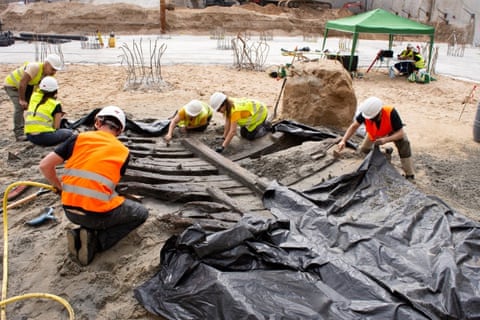Introduction
In a remarkable archaeological breakthrough, a team of researchers in Barcelona, Spain, has unearthed the remains of a large medieval ship, named Ciutadella I, at the site of a former fish market. Discovered during excavations for a new biomedicine and biodiversity center, the vessel is believed to have sunk approximately 500 to 600 years ago, likely in a storm during the 15th or 16th century. This find, announced in April 2025, offers a rare glimpse into medieval shipbuilding techniques and Barcelona’s maritime history.
Discovery and Context
The Ciutadella I wreck was found about 5 meters below sea level at the former Mercat del Peix (fish market), near Ciutadella Park. The excavation site, part of an urban development project led by the Barcelona City Council, has also yielded other historical artifacts, including a Spanish Civil War air-raid shelter, remnants of 18th-century fortifications, and traces of the 19th-century fish market. The ship’s discovery was anticipated due to the site’s proximity to Barcelona’s historic port and an artificial stone quay that protected vessels in the 15th and 16th centuries.

Lead archaeologist Santi Palacios, from the cultural heritage group Arqueòlegs.cat, described the find as “exceptional,” noting its significance in understanding Barcelona’s old port. The vessel, measuring approximately 10 meters long and 3 meters wide, consists of over 30 curved wooden ribs and at least seven hull planks, fastened with wooden dowels and iron nails. This skeletal construction is characteristic of Mediterranean shipbuilding from the mid-15th century, with possible Atlantic influences from regions like the Basque Country or Galicia.
Historical Significance
The Ciutadella I is only the second medieval shipwreck discovered in Barcelona, following the 2008 find of Barceloneta I near the Estació de França railway station. Unlike Barceloneta I, which was of Cantabrian origin, Ciutadella I is believed to be Mediterranean, potentially built along Spain’s eastern coast. The two wrecks provide a unique opportunity for comparative studies of medieval naval construction. Analysis of the ship’s wood, resin, and nails is expected to reveal more about its origin, construction techniques, and the maritime trade networks of the period.

Historical records indicate that Barcelona’s coastline underwent significant changes after the construction of artificial piers in 1439, which altered currents and buried parts of the shoreline under sand and silt. The Ciutadella I likely became a derelict vessel, abandoned and gradually covered by sediment in what was then open sea. Organic remains, such as hazelnut seeds and pine cones found at the site, may help refine the ship’s dating through radiocarbon analysis.
Preservation Efforts
The ship’s timbers, preserved for centuries in waterlogged soil, are extremely fragile. To prevent decay upon exposure to air, archaeologists are keeping the wreck damp using sand and water. Restorer Delia Eguiluz emphasized the need to maintain constant moisture, stating, “The wood has to be kept constantly damp so as to keep it in a good state.” The team is employing 3D photogrammetry to document the wreck and is labeling each piece for future study.
In the next phase, the wreck will be dismantled piece by piece and transported to a specialized facility, where it will be treated with polyethylene glycol, a water-soluble wax, to stabilize the wood. This meticulous process, which could take years, underscores the challenges of preserving underwater archaeological finds.
Broader Implications
The discovery of Ciutadella I highlights Barcelona’s importance as a medieval maritime hub. Together with Barceloneta I, it provides valuable insights into the diversity of shipbuilding techniques and the city’s role in international trade during the late Middle Ages. The ongoing excavations, which have yet to cover up to 15% of the site, may uncover additional parts of the ship or evidence of the storm that led to its demise.
The find has generated significant interest, with posts on X reflecting excitement about its implications for understanding Barcelona’s maritime past. For example, users have noted the wreck’s potential to expand knowledge of medieval naval architecture and its rarity as only the second such discovery in the city.
Conclusion
The Ciutadella I shipwreck is a testament to Barcelona’s rich maritime heritage and the enduring value of archaeological exploration. As researchers continue to study and preserve this fragile relic, it promises to deepen our understanding of medieval shipbuilding and the vibrant trade networks that once connected the Mediterranean world. The discovery serves as a reminder of the hidden treasures buried beneath modern cities, waiting to reveal stories from centuries past.